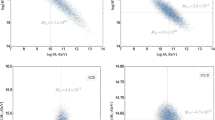Summary
A systematic comparison between the predictions of unbrokenSU 3 and experiment regarding strong decays of accepted and potential supermultiplets is presented. It is found that the accepted supermultiplets (J P=3/2+, 1−, 2+) are in reasonable agreement with predictions, while the hypothetical 3/2− and 5/2+ cases are not.
Riassunto
Si espone un confronto sistematico fra le predizioni della simmetriaSU 3 non infranta e gli esperimenti riguardanti i decadimenti forti dei supermultipletti accettati e potenziali. Si trova che i supermultipletti accettati (J P=3/2+, 1−, 2+) sono in ragionevole accordo con le previsioni, mentre non lo sono i casi ipotetici 3/2− e 5/2+.
Similar content being viewed by others
References
We consider two-body decays only. (One exception, namely the 3π decay of vector meson isosinglets is discussed in footnote (19)).
For the 1−, 3/2+, 3/2− and 5/2+ cases, seeS. Glashow andA. Rosenfeld:Phys. Rev. Lett.,10, 192 (1963); andM. Gourdin:Erg. Exakt. Natur.,36, 1 (1964).
For the 2+ case seeS. L. Glashow andR. H. Socolow:Phys. Rev. Lett.,15, 329 (1965).
For vector mesons seeS. Okubo:Phys. Lett.,5, 165 (1963);J. J. Sakurai:Phys. Rev. Lett.,9, 472 (1962);M. Gell-Mann, D. Sharp andW. G. Wagner:Phys. Rev. Lett.,8, 261 (1962).
One can of course consider potential meson supermultiplets as well. For example the set {B (1220), C° (1225), D (1280) and E (1415)} is a candidate for 1+ nonet status, and can be so accomodated provided D, E mixing is assumed. However, there are serious questions as to the nature of the B and C mass peaks. This, together with the fact that the decay modes are only very crudely known, makes any analysis highly problematical at the present time.
M. Gell-Mann: CTSL-20 (1961);S. Okubo:Progr. Theor. Phys.,27, 949 (1962).
See tables ofJ. J. De Swart:Rev. Mod. Phys.,35, 916 (1963). TheSU 3 factors are summarized in Tables II and III.
A. J. Macfarlane andR. H. Socolow: Syracuse University Preprint NYO-3399-44 (1965).
TheD/F ratio is described in Table III by the parameter α, where (1−α)/α=D/F For the 2+ decays α≡G/F in the notation of ref. (3) For the 2+ case see.
This prescription is very close, but not identical to that used in the various references of footnote (2).For the 1−, 3/2+, 3/2− and 5/2+ cases, see.
J. M. Blatt andV. F. Weisskopf:Theoretical Nuclear Physics (Reading, Mass., 1952), p. 361.
R. E. Behrends andL. F. Landowitz:Phys. Rev. Lett.,11, 296 (1963)
V. Gupta andV. Singh:Phys. Rev.,136, B 782 (1964);C. Beechi, E. Eberle andG. Morpurgo:Phys. Rev.,136, B 808 (1964);E. Johnson andE. McCliment:Phys. Rev.,139, B 591 (1965).
In addition, the sum rules provided by brokenSU 3 are a priori more easily satisfied than the equalities provided in the present approach.
A. H. Rosenfeld, A. Barbaro-Galtieri, W. H. Barkas, P. L. Bastien, J. Kirz andM. Roos:Rev. Mod. Phys.,37, 633 (1965).
R. Armenteros,et al.:Phys. Lett.,19, 75 (1965).
J. Badier, M. Demoulin, J. Goldberg, B. P. Gregory, C. Pelletier, G. Rouge, M. Ville, R. Barloutaud, G. Levèque, C. Louedec, J. Meyer, P. Schlein, A. Verglas, D. J. Holthuizen, W. Hoogland, J. C. Kluyver andA. G. Tenner:Phys. Lett.,19, 612 (1965); Brookhaven National Laboratory-Syracuse University Collaboration (private communication).
seeLondon et al. (ref. (20))
S. Meshkov, G. A. Snow andG. B. Yodh:Phys. Rev. Lett.,12, 87 (1964).
For a review of the situation, seeJ. Leitner:An Experimentalist's View of SU 3 , Syracuse University, ONR report ONR-tt-1 (unpublished). This statement depends upon the octet nature of the breaking interaction. Clearly, one can always fit the data with small additional terms if one allows all sorts of breaking, with concomitantly large number of parameters.
Author information
Authors and Affiliations
Additional information
This work was supported by the U. S. Atomic Energy Commission and the Office of Naval Research.
Traduzione a cura della Redazione
Rights and permissions
About this article
Cite this article
Goldberg, M., Leitner, J., Musto, R. et al. Strong decay rates andSU 3. A comparison and critique. Nuovo Cimento A (1965-1970) 45, 169–178 (1966). https://doi.org/10.1007/BF02738084
Received:
Published:
Issue Date:
DOI: https://doi.org/10.1007/BF02738084




